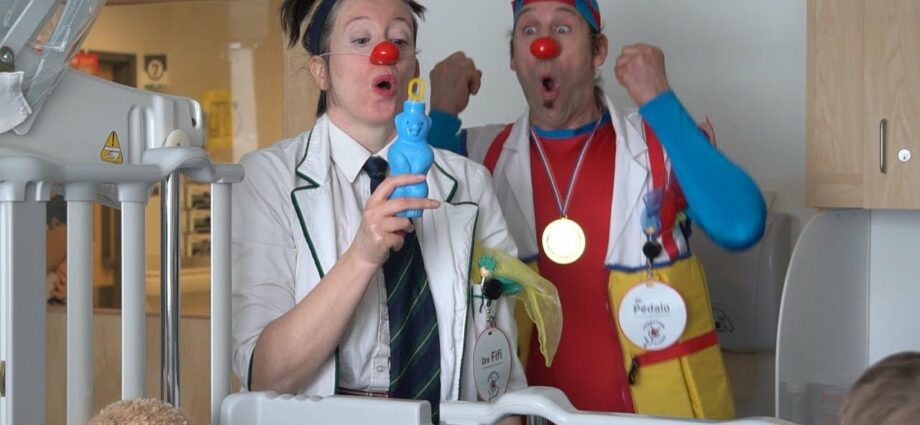Contents
Clowns in the hospital
At the Louis Mourier hospital in Colombes (92), the clowns of the “Rire doctor” come to animate the daily lives of sick children. And more. By bringing their good humor to this pediatric service, they facilitate care and bring a smile to young and old alike. Reporting.
An enchanted parenthesis for the child
It is the hour of the visit. In a well-ordered ballet, white coats follow one another from room to room. But down the hall, another tour started. With their colorful outfits, their grimaces and their red false noses, Patafix and Margarhita, the “Laughing doctor” clowns, inoculate the children with a dose of good humor. Like a magic potion, with tailor-made ingredients and dosage for everyone.
This morning, before entering the scene, Maria Monedero Higuero, alias Margarhita, and Marine Benech, alias Patafix, in fact met the nursing staff to take the “temperature” of each small patient: his psychological and medical state. In room 654 of the pediatric ward of Louis Mourier hospital in Colombes, a tired-looking little girl is watching cartoons on television. Margarhita gently opens the door, Patafix at her heels. “Ooooh, push yourself a little, Patafix! You’re my girlfriend, okay. But what are you sticky … “” Normal. I’m from the FBI! So my job is to stick people together! The aftershocks fuse. At first a little taken aback, the little one quickly lets herself be caught up in the game. Margarhita has drawn her ukulele, while Patafix sings, dancing: “Pee on the grass …”. Salma, finally out of her torpor, slips out of her bed to sketch, laughing, a few dance steps with the clowns. Two rooms further on, it’s a child sitting in his bed who is chuckling, his pacifier in his mouth. His mother will not come until the end of the afternoon. Here, no arrival with fanfare. Slowly, with soap bubbles, Margarhita and Patafix will tame him, then by deploying force of facial expressions, will end up making him smile. Twice a week, these professional actors come to animate the daily life of sick children, just to take them outside the hospital walls for a moment. “Through play, stimulation of the imagination, the staging of emotions, clowns allow children to rejoin their world, to recharge their batteries”, explains Caroline Simonds, the founder of Rire Médecin. But also to regain some control over his own life.
Laughter against pain
At the end of the hall, when they have barely poked a head in the room, a “Get out!” Resounding greets them. The two clowns do not insist. “In the hospital, the children are obeying all the time. It’s hard to refuse a bite or change the menu on your meal tray… There, by saying no, it’s a way of simply regaining a little freedom, ”explains Marine-Patafix in a soft voice.
However, there is no question of opposing the good and the bad here. Clowns and nursing staff work hand in hand. A nurse comes to call them to help. It’s for little Tasnim, 5 and a half years old. She suffers from pneumonia and is afraid of injections. By improvising sketches with the many soft toys lined up on his bed, the two red noses will gradually gain his confidence. And soon the first laughs fuse around a beautiful “strawberry” dressing. The anguish of the little girl subsided, she hardly felt the sting. Clowns are neither therapists nor shrinks, but studies have shown that laughter, by diverting attention from pain, can alter the perception of pain. Better still, researchers have shown that it can release beta-endorphins, kinds of natural painkillers in the brain. A quarter of an hour of “real” laughter would increase our pain tolerance threshold by 10%. At the nursing station, Rosalie, the nurse, confirms in her own way: “It’s easier to take care of a happy child. “
Staff and parents also benefit
In the corridors, the atmosphere is not the same. This red nose in the middle of the face succeeds in breaking down barriers, breaking codes. The white coats, gradually won over by the joyful atmosphere, compete with jokes. “For caregivers, it’s a real breath of fresh air,” admits Chloe, a young intern. And for parents, it is also regaining the right to laugh. Sometimes even more. Maria recounts this brief encounter, in a room in the ward: “It was a 6-year-old girl, who arrived in the emergency room the day before. Her daddy explained to us that she had had a seizure and that she hadn’t remembered anything since. Didn’t even recognize him anymore… He begged us to help him stimulate her. In our game with her, I asked her: “What about my nose? What color is my nose? ” She answered without hesitation: “Red!” “What about the flower on my hat?” “Yellow !” Her daddy started to cry softly as he hugged us. Moved, Maria pauses. “Parents are strong. They know when to put stress and anxiety aside. But sometimes, when they see their sick child playing and laughing like all the other little ones their age, they crack. “
A profession that cannot be improvised
Hidden behind their disguise, the clowns of Laughing Doctor must also remain strong. Clowning in the hospital cannot be improvised. They are therefore specially trained and always work in pairs to support each other. With its 87 professional actors, “Le Rire Médecin” is now involved in nearly 40 pediatric departments, in Paris and in the regions. Last year, more than 68 visits were offered to hospitalized children. But outside, night is already falling. Margarhita and Patafix took off their red noses. Franfreluches and ukulele have been stored at the bottom of a bag. Marine and Maria slip away from the service incognito. The children are impatiently awaiting the next prescription.
To make a donation and offer a smile to the children: Le Rire Médecin, 18, rue Geoffroy-l’Asnier, 75004 Paris, or on the web: leriremedecin.asso.fr










